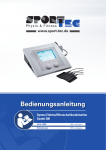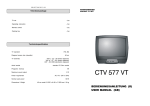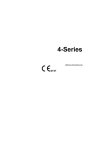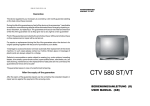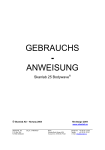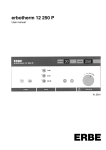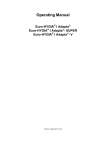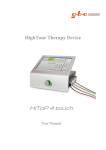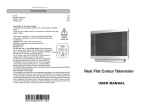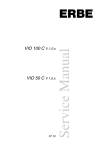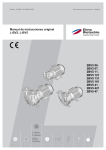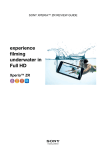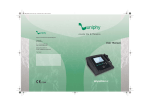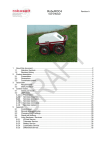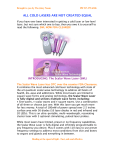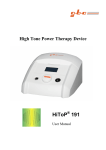Download erbosonat Ultrasound Therapy Unit User Manual
Transcript
ERBE erbosonat Ultrasound Therapy Unit User Manual Type Nr. 10205-010 / V 1.3 10.98. erbosonat Ultrasound Therapy Unit User Manual Type Nr. 10205-010 / V 1.3 Manual part number 80122-001 All rights reserved. No part of this document may be translated, stored in information retrieval systems, or transmitted in any form or by any means - electronic or mechanical, including photocopying, recording or otherwise - without the written permission of ERBE Elektromedizin. Printed by ERBE Elektromedizin, Tübingen Printed in Germany Copyright ERBE Elektromedizin GmbH, Tübingen 1998 Chapter Title Page 1 Important Foreword..........................................................1-1 2 2.1 2.2 2.3 Physical Principles of Ultrasonic Therapy ......................2-1 What is Ultrasound? ............................................................2-2 Ultrasound Generation.........................................................2-2 Physical Principles of Therapeutically Relevant Effects of Ultrasound .......................................................................2-2 Concerted Utilization of Non-Thermal and/or Thermal Effects ..................................................................................2-4 2.4 3 3.1 3.2 3.3 3.4 Therapeutic Effects of Ultrasound, Undesirable Side Effects....................................................3-1 General.................................................................................3-2 Non-Thermal Effects ...........................................................3-2 Thermal Effects....................................................................3-2 Undesirable Side Effects......................................................3-3 4 4.1 4.2 Ultrasonic Radiation Methods..........................................4-1 Continuous Ultrasound ........................................................4-2 Pulsed Ultrasound................................................................4-2 5 5.1 5.2 Treatment Technique ........................................................5-1 Coupling using Ultrasonic Gel, Liquid Paraffin, etc. ..........5-2 Subaqueous Coupling ..........................................................5-2 6 6.1 6.2 6.3 Dosage, Indications, Additional Treatment Information ........................................................................6-1 Indications............................................................................6-2 Contraindications ................................................................6-2 Additional Treatment Information.......................................6-3 7 7.1 7.2 7.3 7.4 7.5 Description and Operation................................................7-1 General Description ............................................................7-2 Description of the Control Elements ...................................7-3 Ultrasound Operation...........................................................7-6 Operation in Combination with the erbogalvan ..................7-6 Technical Specifications......................................................7-8 8 Installation and Initial Operation ....................................8-1 9 9.1 9.2 Cleaning and Disinfection .................................................9-1 Unit ......................................................................................9-2 Ultrasound Applicators........................................................9-2 10 10.1 10.2 Maintenance, Care, Disposal ..........................................10-1 Maintenance of the unit accessories ..................................10-2 Modifications and repairs ..................................................10-2 Care of the Ultrasound Applicators ................................................10-2 Disposal of the unit.........................................................................10-2 11 Functional Testing ...........................................................11-1 12 12.1 12.2 Safety Inspections ............................................................12-1 Equipment..........................................................................12-2 Ultrasound Applicators......................................................12-2 13 Accessories........................................................................13-1 14 Warranty ..........................................................................14-1 15 Literature, Regulations, Standards, Legislation...........15-1 Addresses 1 Important Foreword 1. Important Foreword The erbosonat has been checked for proper and safe operation prior to shipment. However, in order to detect any damage that may have occurred in shipment and to verify the equipment has been correctly installed, the equipment should be rechecked for proper and safe operation after installation, prior to initial operation, and before each subsequent use. The erbosonat ultrasonic therapy unit should be used on patients exclusively by personnel familiar with the features and operation of the equipment. In order to prevent accidental injuries due to faults occurring in, or to failures of the equipment or of any of its accessories, the equipment and all of its accessories should be regularly checked for proper and safe operation. These checks should be performed exclusively by personnel whose knowledge, training and practical experience qualifies them to perform such checks. Please see page 12-2 1-2 2 Physical Principles of Ultrasonic Therapy 2. Physical Principles of Ultrasonic Therapy A prerequisite for the efficient and, for the patient, safe application of ultrasonic therapy is an understanding of the physical principles of ultrasound as well as the effects which ultrasound can cause in biological tissues. 2.1 What is Ultrasound? Ultrasound refers to mechanical oscillations, or vibrations, at frequencies above the audible range of the human ear, that is, above about 20 kHz. Ultrasonic therapy uses frequencies from about 800 kHz to about 3000 kHz. The vibration amplitude depends, among other things, on the power density (watts/cm2) and is about 0.00003 mm. This very small vibration amplitude hardly gives the impression that it can achieve a therapeutic effect in biological tissue. At 1000 000 vibrations per second and a vibration amplitude of 0.00003 mm, however, the constituent particles travel the remarkable distance of 4 x 1000 000 x 0.00003 mm = 12 cm. Even more remarkable is the fact that the generation of these vibrations requires an acceleration of approx. 1000 000 m/s2. This acceleration is 100 000 times greater than the acceleration due to the earth’s gravity. 2.2 Ultrasound Generation Ultrasound generation today utilizes mainly the piezoelectric effect of piezoceramics. Piezoceramics are special electrically polarized ceramics. Their density, or volume, can be influenced by an electric field. The change in volume of the ceramic is directly proportional to the electrical charge introduced into it. If a time-varying electrical voltage is applied to a piezoceramic, the volume of the ceramic changes proportionally to the electrical voltage. The change in volume results in a change in length. This occurs in a preferred direction prescribed by the shape and polarization direction of the piezoceramic. Such a component can be called an electromechanical transducer. An ultrasonic therapy device consists basically of an electromechanical transducer and a high-frequency generator. 2.3 Physical Principles of Therapeutically Relevant Effects of Ultrasound Ultrasound can cause non-thermal as well as thermal effects. 2.3.1 Non-Thermal Effects Non-thermal effects of ultrasound in biological tissue result from the high accelerative forces. Even at a power density of 1 W/cm2, these are about 100 000 times the acceleration due to the earth’s gravity. Unfortunately, little has been learned up to now about the relationships between physical, physiological, and/or biochemical effects. The corresponding statements are mainly empirical and hypothetical. Probably the most well-known effect of ultrasound is the cavitation of water-containing tissue. Cavitation is characterized by the formation of microscopic bubbles in intra- and extracellular fluids when a critical acceleration is exceeded. These bubbles can cause tissue fractionation. The cavitation effect is used in ultrasonic surgery for tissue dissection and must 2-2 be avoided in ultrasonic therapy at all costs. Producing the cavitation effect requires very high power densities. These cannot be achieved when the erbosonat is properly used. 2.3.2 Thermal Effects The ultrasonic energy radiated into tissue is absorbed by the tissue and transformed endogenously into heat. The heat produces thermal effects such as hyperemia, which in turn influences the metabolic processes in the ultrasonically irradiated tissue. The thermal effects of ultrasound are similar to the thermal effects of shortwave, decimetricwave, or microwave therapy. The differentiation from these HF therapies lies solely in the application technique. Ultrasonic therapy is characterized by the fact that a more directed application is possible than with the HF-therapeutic procedures. This is especially true in the treatment of diseased joints. Moreover, ultrasound has a further advantage in the treatment of joints: due to the reflection of the ultrasound by hard tissue (cartilage, bones), there is increased warming in the interface between the hard and soft tissue. NOTE! Excessive local application of ultrasonic energy can cause thermal tissue damage. For this reason, at high ultrasonic power levels, an ultrasound applicator must not be applied too long to one location. 2-3 2.4 Concerted Utilization of Non-Thermal and/or Thermal Effects In general, ultrasound simultaneously produces non-thermal as well as thermal effects. The non-thermal effects depend chiefly on the level of acceleration, or the power density. The endogenous heat generation is proportional to the ultrasonic energy radiated into the tissue. The ultrasonic energy radiated into tissue is proportional to the effective ultrasonic power and the duration. By modulating the amplitude of the ultrasound, the non-thermal effects can be emphasized and at the same time the thermal effects reduced. Pulse modulation is advantageous in this case. 2-4 3 Therapeutic Effects of Ultrasound, Undesirable Side Effects 3. Therapeutic Effects of Ultrasound, Undesirable Side Effects 3.1 General Whether ultrasound generates therapeutic and/or undesirable side effects depends mainly on the dosage and the application technique. According to the current state of knowledge, it can be assumed that tissue damage cannot occur when ultrasound is properly used. Since ultrasound applied in therapeutic doses shows no persistent effects, endangerment of the patient as a result of cumulative effects can be ruled out, even in the case of repeated applications. With respect to therapeutic effects, the distinction is made between primary and secondary effects. Primary effects are the accelerative forces generated by ultrasound and the transformation of ultrasonic energy into heat. The primary effects in turn cause secondary effects: these can be categorized as non-thermal and thermal effects. 3.2 Non-Thermal Effects Unfortunately, no scientific information concerning non-thermal effects is available, rather only hypotheses. Our knowledge is based on comprehensive empirical experience. The following are hypothetical causes for non-thermal effects of ultrasound: l Piezoelectric effects, especially in bone. The pressure waves deform fibrils and fibers and induce electrical potentials. Result: Increased cell activity. Influence on membrane permeability, including that for ions. l Deformation of fibrils and fibers with induction of electrical potentials. Result: Increased activity of fibroblasts and osteoblasts. The non-thermal effects are proportional to the intensity of the ultrasound or the accelerative forces caused by the ultrasound. 3.3 Thermal Effects In principle, the thermal effects of ultrasound do not differ from the thermal effects of highfrequency diathermy. The two procedures differ only in the application technique and the selectivity of the heat generation. In high-frequency diathermy, endogenous heat generation depends in particular on the electrical properties of the various tissues. With ultrasonic diathermy, on the other hand, endogenous heat generation depends in particular on the mechanical properties of the various tissues. Ultrasonic diathermy is preferable to high-frequency diathermy when directed to certain regions such as joints. In both diathermy procedures, the heat or temperature serves as a stimulus for triggering secondary effects such as hyperemia and analgesia. The thermal effects are proportional to the ultrasonic energy introduced into the tissue. 3-2 3.4 Undesirable Side Effects 3.4.1 Cavitation Cavities containing gas or vapor can form during the negative-pressure phase of the ultrasonic wave. The microscopic bubbles can implode and trigger intensive mechanical effects and temperature jumps. Cavitation is not possible when the currently-employed low-dosage recommendations are followed, when dynamic ultrasonic radiation (moving ultrasound applicator) is used, and when the equipment is functioning properly. 3.4.2 Pain Sensations Intensive heat generation at the muscle-bone interface is desirable for many therapeutic applications, but it can lead to pain sensations at the sensitive periosteum. Remedy: Use low dosage; do not use the applicator too long in one location; and question the patient concerning pain. 3.4.3 Impaired Thermal Sensitivity Due to Medication Ensure that the patient has not taken medication affecting thermal sensitivity. 3-3 3-4 4 Ultrasonic Radiation Methods 4. Ultrasonic Radiation Methods The following ultrasonic radiation methods can be distinguished with respect to the therapeutic effects: 4.1 Continuous Ultrasound Continuous ultrasound is unmodulated, continuous-wave ultrasound. Continuous ultrasound is indicated when the thermal effects of ultrasound are called for. 4.2 Pulsed Ultrasound Pulsed ultrasound is pulse-modulated ultrasound. Pulsed ultrasound is indicated when the non-thermal effects of ultrasound are called for. 4-2 5 Treatment Technique 5. Treatment Technique Since ultrasound is completely reflected by air layers, a coupling medium must be present between the ultrasound applicator and the patient’s skin. With respect to coupling of ultrasound to tissue, the following methods are distinguished: 5.1 Coupling using Ultrasonic Gel, Liquid Paraffin, etc. Before applying the radiating surface of the ultrasound applicator to the area to be treated, apply a thin film of warmed coupling medium to the parts of the body to be treated. If the coupling is interrupted during treatment due to tilting of the ultrasound applicator, the electronic contact monitor of the erbosonat will turn off the ultrasound and generate an alarm. Subaqueous coupling is recommended for treating uneven parts of the body. 5.2 Subaqueous Coupling Subaqueous coupling is particularly suitable for treating: l ulcers and lesions for which the treatment surface must not be touched directly, l finger joints, ankles, toes, elbows, or bone prominences, where the surface would be too small and/or uneven for irradiation, l pressure-sensitive body parts. In subaqueous application, the part of the body to be treated is immersed in a water-filled vessel and the ultrasound applicator is directed under water to the area to be treated. Since water is a good conductor of ultrasound, the ultrasound applicator in this case can be guided at a distance of 0.5 to 2 cm. Direct contact between the ultrasound applicator and the skin is not required. Gas bubbles in water, on the patient’s skin, and/or on the contact surface of the ultrasound applicator are impermeable to ultrasound and must be removed. The water temperature should be comfortable for the patient. When using ultrasound for local heat therapy, the water should of course be warm. An applicator extension handle is available for subaqueous application, so that the therapist need not immerse his/her hand in water. The vessel employed for the water bath must be non-metallic and positioned so that it is electrically insulated. 5-2 6 Dosage, Indications, Additional Treatment Information 6. Dosage, Indications, Additional Treatment Information EDEL (1983) gives the following approximate values for ultrasonic intensity and treatment duration: Ultrasonic intensity Low intensity: Medium intensity: High intensity: 0.05 to 0.4 W/cm2 0.5 to 0.7 W/cm2 0.8 to 1.2 W/cm2 Treatment duration: Low dosage: Medium dosage: High dosage: 1 to 3 min 4 to 6 min 7 to 12 min PLEASE NOTE: With continuous ultrasound, a slight sensation of warmth indicates the upper dosage limit. Treatment series: Acute diseases: up to 6 sessions, repeated every one or two days. Chronic diseases: up to 12 sessions, three times a week. After each series of treatments, a pause in treatment is indicated. KNOCH / KNAUTH (1972) give detailed, indication-based dosage information. 6.1 Indications Due to its multi-faceted and complex mechanism, ultrasonic therapy has a wide indication spectrum. EDEL lists the following primary indications: l Diseases and injuries to the locomotor and supporting apparatus l Inflammatory diseases of a rheumatic nature l Degenerative diseases of the joints and spinal column l Internal diseases, such as bronchial asthma and functional diseases of the gastrointestinal tract l Dermatological diseases, such as circumscribed scleroderma, scar keloids, and ulcus cruris varicosum KNOCH / KNAUTH (1972) provide detailed information on a wide variety of indications in surgery and orthopedics, internal medicine, and neurology. 6.2 Contraindications according to EDEL (1983), KNOCH / KNAUTH (1972) General contraindications: l All diseases in which heat is contraindicated l Malignant tumors l Febrile conditions of uncertain as well as known genesis l Poor general condition and marasmus l Acute infections 6-2 l Active tuberculosis l Vascular diseases of the extremities, such as thrombophlebitis, thrombosis, and varicosis l Advanced, severe arterial peripheral circulatory disturbances (stages III and IV according to LA FONTAINE) l Circulatory insufficiency, diseases of the coronary vessels, cardiac rhythm disturbance l Blood coagulation disorders l Acute rheumarthritis l Cardiac pacemakers The following must not be subjected to direct ultrasonic radiation: l Brain and spinal cord l Liver, spleen, ovaries of the pregnant uterus, and gonads l Heart and lungs, as well as cardiac segments in functional cardiac disease l Epiphyseal areas in children l Arteriosclerotically altered vessels, varicose veins l Eyeballs Caution should be exercised with: l Anesthetized areas of the skin or impaired skin sensitivity due to other causes l Bone prominences l Laminectomy scars (due to reduced coverage of the spinal cord) Not contraindicated is: l The presence of metallic implants in the depth of tissue or of hip joint endoprostheses, in therapeutic dosage and under dynamic ultrasonic irradiation. 6.3 Additional Treatment Information Positioning of the patient also affects the success of therapy. The patient should be as relaxed as possible, without pain. Various positions such as extension, package, and crescent, are described by KNOCH and KNAUTH (1972). Cold extremities must undergo preparatory heat treatment. A recovery period of 20 - 30 minutes is beneficial. 6-3 6-4 7 Description and Operation 7. Description and Operation 7.1 General Description The erbosonat is an electromedical unit for ultrasonic therapy. It can be employed alone for pure ultrasonic therapy as well as in combination with an electro-stimulation therapy unit for simultaneous stimulation current. The erbosonat has the following features: Ultrasound parameters The nominal frequency is 1 MHz. When using an ultrasound applicator with an effective contact surface of 2.5 cm2, the ultrasonic power can be adjusted up to a maximum of 7.5 watts. For ultrasound applicators with an effective contact surface of 5.0 cm2, the maximum adjustable ultrasonic power is 15 watts. Ultrasound can be applied continuously as well as in pulsed mode. For pulsed-mode application, three different pulse/pause modes are available. Configuring the ultrasound parameters is accomplished in a straightforward manner via a large control knob and an Okay button. By briefly pressing the Okay button, the ultrasound parameters effective therapy duration, ultrasound modes (continuous/pulsed), and intensity are called up. The respective parameter can then be adjusted for the respective application by rotating the large control knob. Ultrasound applicators For ultrasonic therapy, two different ultrasound applicators are available, with effective 2 2 contact surfaces of 2.5 cm (ERBE part no. 20205-001) and 5.0 cm (ERBE part no. 20205000), respectively. These ultrasound applicators have watertight construction and are thus suitable for subaqueous (underwater) application. For simultaneous electro-stimulation therapy, the metal contact surface of these ultrasound applicators is electrically conductive. The ultrasound applicators are also electrically coded. The erbosonat automatically recognizes them and automatically configures the ultrasound parameters for the respective connected ultrasound applicator. For subaqueous application, an extension handle is available to allow the therapist to use the applicator without immersing his/her hand in water. The ultrasound applicators have integrated green LEDs. These illuminate when the applicator is in sufficient contact with the patient’s skin. The LEDs are recessed into the ultrasound applicators and are thus protected from impact. Automatic monitoring of the effective contact between the ultrasound applicator and the patient The erbosonat is equipped with a function that automatically monitors the effective contact between the radiating surface of the applicators and the patient’s skin. The selected ultrasonic power is radiated only when the ultrasound applicator has sufficiently good contact with the patient’s skin. If the effective contact between the ultrasound applicator and the patient’s skin is inadequate, the ultrasonic power is reduced automatically. The therapy timer of the erbosonat considers only the effective therapy time, the time in which the effective contact surface is sufficiently good. The ultrasound applicators are equipped with green LEDs. These illuminate when the effective contact surface is adequately large. In addition, the erbosonat has an acoustic signal. The signal sounds when the effective contact becomes unsatisfactory. The acoustic signal can be disabled by a switch on the rear panel of the unit. 7-2 Therapy timer The therapy timer considers only the effective therapy duration, the time during which there is effective contact between the ultrasound applicator and the patient’s skin. After expiration of the previously set effective therapy duration, the therapy timer automatically turns off the generator of the erbosonat and triggers an acoustic signal. Setting of the effective therapy duration is in steps of 1 minute. The remaining time is displayed. When simultaneously using an erbogalvan comfort, the therapy timer of the erbosonat automatically disconnects the stimulation current. Basic setting After each activation of the erbosonat’s power switch, the following basic settings for the ultrasound parameters are displayed following completion of the automatic self-test: Effective therapy duration: Ultrasound mode: Ultrasonic intensity: 10 minutes 1:10 0.0 watts/cm2 Power display Display of the intensity or ultrasonic power can be in either watts or watts/cm2. In the basic 2 setting, the display is always in watts/cm . To enter the intensity in watts, any value in 2 2 watts/cm must already be set. Press the Okay button, and the display changes from watts/cm to watts. Pressing the Okay button again switches back to the watts/cm2 display. Automatic error recognition and display The erbosonat is equipped with an automatic error recognition and reporting function. After each activation of the power switch, the unit conducts an automatic self-test. During this 3second self-test, all optical signals illuminate and the acoustic signal sounds. The user should always verify that all optical signals are properly illuminated and the acoustic signal correctly sounds. If functional errors are detected automatically during the self-test, they are indicated by error numbers on the 7-segment display on the front panel of the unit. Error No. H 1.1 Error No. H 1.2 = = Large ultrasound applicator defective Small ultrasound applicator defective Simultaneous electro-stimulation therapy The erbosonat can be optimally combined with an erbogalvan comfort, erbogalvan e, or an erbogalvan e2 electro-stimulation therapy unit. After connecting the two units, the applicator head of the erbosonat not only transmits ultrasonic waves but at the same time functions as a (movable) stimulation current electrode. The combined effect of electrostimulation and ultrasound is highly valued in physical therapy. In many cases, it is more effective than stimulation current or ultrasound alone. 7.2 Description of the Control Elements 1 Power switch After each activation of the power switch, all optical indicators and signals are illuminated for 3 seconds. An acoustic signal also sounds. At this time, the user should always verify that all optical signals illuminate correctly and that the acoustic signal sounds. At the same time, an automatic self-test is run. If an error is detected, it is displayed as an appropriate error number. 7-3 2 Connection socket for large or small ultrasound applicators This socket supports the connection of either small ultrasound applicators with a contact sur2 face of 2.5 cm (ERBE part no. 20205-001) or large ultrasound applicators with a contact surface of 5 cm2 (ERBE part no. 20205-000). The unit automatically recognizes which ultrasound applicator is connected. If none is connected, the unit reminds the user with the display head (=ultrasound applicator) in the therapy timer display. NOTE! Use only the ERBE ultrasound applicators No. 20205-001 (2.5 cm2) or No. 20205-000 (5.0 cm2). 3 Selector for setting all relevant parameters With this control knob, you can successively set all parameters relevant to the ultrasonic therapy: Ultrasound modes (i:p), Ultrasonic intensity (W or W/cm2) Effective therapy duration (min:sec) After any of these parameters has been set as desired, the setting must be confirmed by pressing the Okay button. 4 Okay button By briefly pressing this button, you can successively select the three parameters Effective therapy duration, Ultrasound modes (continuous or pulsed), and Ultrasonic intensity and accomplish the setting by turning the select control knob. 5 Therapy timer The timer can be set with the Effective therapy duration in 1 minute steps up to a maximum of 30 minutes. Effective therapy duration is the time during which there is sufficient contact between the ultrasound applicator and the patient’s skin. The timer counts down in 1 second steps and displays the remaining time. After expiration of the preset therapy duration, the timer automatically disconnects the unit’s HF generator and initiates an acoustic signal. NOTE! You can set the therapy timer only when the intensity display is 0.0 watts or watts/cm2. The therapy timer runs only when you have set an intensity greater than 0.0. The blinking point between the minutes and seconds displays indicates that the timer is running. 6 Ultrasound mode The ultrasound mode is displayed here. The possible values and their meanings are: c = continuous ultrasound In pulsed-mode operation, the ratio of pulse duration to period (duration of the pulse plus duration of the interpulse period) is given in ms. This ratio is called the pulse-duty factor. The larger the selected pulse-duty factor, the less heating of tissue occurs. 1:3 1:5 1 : 10 = = = pulsed ultrasound pulsed ultrasound pulsed ultrasound i = 3.3 ms i = 2.0 ms i = 1.0 ms 7-4 p = 10 ms p = 10 ms p = 10 ms 7 Ultrasonic intensity You can set the ultrasonic intensity in steps of 0.1 watt or 0.1 watt/cm2. When using an ultrasound applicator with a contact surface of 2.5 cm2 (ERBE part no. 20205-001), the ultrasonic intensity can be adjusted up to a maximum of 7.5 watts or 3.0 watts/cm2. When using an ultra2 sound applicator with a contact surface of 5 cm (ERBE part no. 20205-000), you can adjust the ultrasonic intensity up to a maximum of 15 watts or 3 watts/cm2. 8 Optical signal by skin/applicator contact monitor This signal illuminates when the contact between the applicator and the patient’s skin is adequate. 9 Input socket for stimulation current with simultaneous application of ultrasound and stimulation current The stimulation current fed into this socket is passed within the erbosonat to the connection socket for ultrasound applicators and subsequently to the contact surface of the ultrasound applicator. 7-5 NOTE! When simultaneously applying ultrasound and stimulation current, the circuit for the stimulation current must be established. This is accomplished by using an electrode of sufficient surface area, applied to the patient and connected via cable to the electro-stimulation therapy unit. 10 Line plug The erbosonat may be used only with a power cord supplied by the equipment manufacturer for this unit. If you use another cord, it must be of equivalent quality and bear the national test symbol. The erbosonat may be connected only to properly installed grounded sockets. For safety reasons, multi-socket taps and/or extension cords should not be used. If they are unavoidable, they must have a properly functioning ground conductor. 11 Line fuses If one or both of the line fuses blow, they must be replaced by equivalent replacement fuses. Before replacing fuses, it is recommended that the cause for the blown fuse be determined. This should be left to a specialist. In any case, the unit should be used again only after a specialist has performed a safety inspection of the unit (see Chapter 12, Safety Inspections). 12 On/off switch for automatic contact monitor acoustic signal The automatic contact monitor generates an acoustic signal when the effective contact between the ultrasound applicator and the patient’s skin becomes insufficient. In addition, the green LED on the applicator is extinguished. The therapist can disable the acoustic signal and monitor correct application via the LED alone. If necessary (e.g., when the green LED is not visible during application), the acoustic signal can be re-enabled. 7.3 Ultrasound Operation 1. Turn on the power switch. 2. Connect large or small ultrasound applicator to socket 2. 3. Using the Okay button, successively select the intensity mode, the therapy timer, and the ultrasound mode. For each mode, set the desired value with the selector. When you move to the next parameter with the Okay button, the current value is stored. When all parameters have been set and the contact between the applicator and skin is adequate (use ultrasonic gel!), the timer begins to count down. The green LED on the applicator illuminates, and the unit radiates ultrasonic waves. 4. When the preset therapy duration expires, the timer turns off the generator and initiates an acoustic signal. 7.4 Operation in Combination with the erbogalvan comfort, erbogalvan e, erbogalvan e2 1. Turn on the power switch. 2. Connect large or small ultrasound applicator to socket 2. (Figure 1) 3. Connect the ERBE 2-conductor universal cable or the ERBE 4-conductor universal cable as usual to the erbogalvan. (Figure 2, 3) (see operating instructions) 4. With the 4-conductor cable, use either the two light-colored plugs (circuit A) or the two dark-colored plugs (circuit B). 7-6 5. Connect one of the plugs to the erbosonat input socket for stimulation current. (Figure 2, 3) 6. Connect the other plug to an electrode and apply the latter to the patient. (Figure 2, 3) 7. Turn on the electro-stimulation therapy unit and set the desired parameters (see operating instructions). 8. Set the desired parameters for the erbosonat. Using the Okay button, successively select the intensity mode, the therapy timer, and the ultrasound mode. With the selector, set the desired value for each mode. When the Okay button is pressed to move to the next parameter, the current value is stored. Figure 1 Figure 2 Figure 3 7-7 7.5 Technical Specifications erbosonat ERBE Part No. 10205 - 010, Version V 1.3 Power connection Line voltage 230 - 240 V +/- 10 %, 50 / 60 Hz 100 - 120 V +/- 10 %, 50 / 60 Hz 50 VA I T 250 mA at 230 - 240 V line voltage T 500 mA at 100 - 120 V line voltage Maximum power consumption Protection class as per IEC 601-1 Line fuse Ultrasound Frequency Mode C (continuous = unmodulated) Maximum effective ultrasonic output power in mode C Mode 1/3 (pulse-modulated) Mode 1/5 (pulse-modulated) Mode 1/10 (pulse-modulated) Modulation percentage Modulation waveform Maximum ultrasonic output power in modes 1/3, 1/5, and 1/10 (max. pulse power) Pulse frequency Contact monitor between ultrasound applicator and skin of patient 1 MHz Continuous ultrasound 7.5 watts Pulse duration = 3.3 ms/period = 10 ms Pulse duration = 2.0 ms/period = 10 ms Pulse duration = 1.0 ms/period = 10 ms 100% Square wave 15 watts 100 Hz Automatic with optical and acoustic signaling, and with automatic control of therapy timer (effective therapy duration) Therapy timer Adjustable, 1 to 30 minutes. The effective therapy duration is measured in 1second steps. Connection of ultrasound applicators Automatic recognition of small or large ultrasound applicator and automatic setting of maximum HF power Connection type for ultrasound applicators as per DIN BF / VDE 0750 Part 208 Dimensions LxWxD Weight Color Design 400 x 370 x 100 mm 6,7 kg Nextel anthracite Matches "erbogalvan comfort" Environmental Conditions / Tranport and Storage Ambient temperature Relative humidity Between -40 and +70 °C Between 30% and 95%, noncondensing Environmental Conditions / Operation Ambient temperature Relative humidity Between +10 and +40 °C Between 30% and 75%, noncondensing 7-8 Ultrasound applicators Frequency Large-surface ultrasound applicator ERBE part no. 20205 - 000 Small-surface ultrasound applicator ERBE part no. 20205 - 001 1 MHz Effective contact surface 5.0 cm2 Maximum ultrasonic power 15 watts Maximum power density 3 watts / cm2 Effective contact surface 2.5 cm2 Maximum ultrasonic power 7.5 watts Maximum power density 3 watts / cm2 Class in accordance with the regulations of the 93/42/EEC guideline Class IIa 7-9 7 - 10 8 Installation and Initial Operation 8. Installation and Initial Operation The erbosonat ultrasound therapy unit can be used not only for pure ultrasound therapy but also in combination with an erbogalvan comfort electro-stimulation therapy unit for simultaneous electro-stimulation therapy. The following information applies equally to the unit combination. Testing on delivery Immediately on receipt, the erbosonat should be inspected for transportation damage and subjected to functional testing. In the event of damage in transport, this should be reported immediately to the shipping agent and a claim filed for compensation. The claim must contain, in addition to the name and address of the recipient, the date of receipt, model and serial numbers of the delivered unit (see nameplate on the rear panel of the unit), and a description of the damage. The original packaging for the unit should be retained during the warranty period, so that the unit can be returned if necessary in its original packaging. Power connection The erbosonat may be used only with a power cord supplied by the equipment manufacturer for this unit. If you use another cord, it must be of equivalent quality and bear the national test symbol. The erbosonat may be connected only to properly installed grounded sockets. For safety reasons, multi-socket taps and/or extension cords should not be used. If they are unavoidable, they must have a properly functioning ground conductor. Environmental conditions The erbosonat can be operated at a room temperature of between 10 and 40° C. The effective humidity can be between 30 and 75 %, non-condensing. If these tolerances are exceeded in either ways, the unit may break down. Protection against moisture The erbosonat as well as the erbogalvan comfort electro-stimulation therapy unit are resistant to dripping water. Nevertheless, when installing these units, care should be taken not to position the units in the immediate vicinity of hoses or containers with liquids. In any case, liquids must not be placed on top of the units. Furthermore, this unit is not intended for operation in hydrotherapy facilities. Cooling The erbosonat as well as the erbogalvan comfort electro-stimulation therapy unit must be positioned such that air can circulate freely around their cabinets. Installation in narrow niches or shelves is not authorized. Electromagnetic compatibility (EMC) Ultrasound therapy and/or electro-stimulation therapy units should not be operated in the vicinity of high-frequency therapy units, in particular shortwave therapy units. The distance from shortwave therapy units should be at least 10 meters. The distance from microwave or decimetric-wave therapy units should be at least 5 meters. Electromagnetic fields of HF units induce HF voltage in the cables of the ultrasound applicators and/or the cables of the stimulation current electrodes. If the distance is insufficient, the voltage can cause patient burns or functional disorders of the ultrasonic and/or the electro-stimulation therapy unit. NOTE! Electromagnetic fields penetrate walls, floors, and curtains. This must be considered when installing such units in adjacent rooms or enclosures. 8-2 Combination with other equipment When combining the erbosonat with other equipment, it is absolutely essential to ensure that this does not affect the proper functioning of the equipment or the safety of the patient and/or therapist. Combinations related to the application device (ultrasound applicator) of the erbosonat may be used on patients only when, as a minimum, the requirements for type BF as per DIN/VDE 0750 Part 1 are met. Only equipment or accessories having a safety-related certificate of nonobjection may be used in combination with the erbosonat. ERBE is not responsible for damages arising from the combined use of erbosonat with equipment or accessories of other manufacturers. Operation in Combination with the erbogalvan comfort, erbogalvan e, erbogalvan e2 1. Turn on the power switch. 2. Connect large or small ultrasound applicator to socket 2. (Figure 1) 3. Connect the ERBE 2-conductor universal cable or the ERBE 4-conductor universal cable as usual to the erbogalvan. (Figure 2, 3) (see operating instructions) 4. With the 4-conductor cable, use either the two light-colored plugs (circuit A) or the two dark-colored plugs (circuit B). 5. Connect one of the plugs to the erbosonat input socket for stimulation current. (Figure 2, 3) 6. Connect the other plug to an electrode and apply the latter to the patient. (Figure 2, 3) 7. Turn on the electro-stimulation therapy unit and set the desired parameters (see operating instructions). 8. Set the desired parameters for the erbosonat. Using the Okay button, successively select the intensity mode, the therapy timer, and the ultrasound mode. With the selector, set the desired value for each mode. When the Okay button is pressed to move to the next parameter, the current value is stored. Figure 1 8-3 Figure 2 Figure 3 Installation of the ultrasound applicator retainer An applicator retainer is available for the erbosonat. The drawing shows how to install the retainer. RND\ Equipment cart An equipment cart is available for the erbosonat to allow optimal and safe positioning of the unit and accessories. 8-4 9 Cleaning and Disinfection 9. Cleaning and Disinfection 9.1 Unit The unit has a durable Nextel coated surface, which can be cleaned using grease-cutting household cleaners. Please ensure that no liquid is introduced into the unit. Prior to using liquid cleaners, disconnect the power cord. Do not use lint-shedding tissues or paper towels to clean the surface of the unit. Otherwise, fine lint particles will cling to the rough surface. 9.2 Ultrasound Applicators The ultrasound applicators should be cleaned and disinfected regularly after each use. We recommend disinfection by spraying and wiping. Note! In any case, remove the ultrasonic gel from the applicators after each application. Ultrasonic gel dries on the surface of the applicators and can adversely affect their proper functioning. 9-2 10 Maintenance, Care, Disposal 10. Maintenance and Care 10.1Maintenance of the unit and accessories Maintenance of the unit and accessories includes not only preventive but also corrective maintenance. Preventive maintenance involves regular testing of the unit and accessories to avoid accidents resulting from faults due to age and wear and tear of the unit as well as the accessories, the unit along with its accessories must be tested at suitable intervals (at least once a year), by an authorized specialist. 10.2 Modifications and repairs Corrective maintenance involves modifications and repairs to unit and its accessories. It must not impair the safety of the unit for patients, users and the environment. Modifications and repairs must therefore only be carried out by the manufacturer or by qualified service personnel expressly authorized by him. If unauthorized persons carry out improper modifications or repairs to the unit or accessories, then the manufacturer accepts no responsibility in this respect. Claims under warranty are also hereby invalidated. All maintenance work must be documented in a maintenance record. 10.3 Care of the Ultrasound Applicators Note! The applicators have a sensitive piezoceramic transducer. Avoid blows to the radiating surface. Do not drop the applicator on the floor. Remove ultrasonic gel from the radiating surface after each application, and disinfect the applicator on a regular basis. 10.4. Disposal of the unit The unit can be disposed of at the end of its useful life as standard electronic scrap. 10 - 2 11 Functional Testing 11. Functional Testing of the Ultrasound Applicators On the erbosonat, set an ultrasound mode, an ultrasonic intensity, and a therapy duration. The mode or the selected values are not important. Immerse the applicator in water. If bubbles form in front of the radiating surface, the applicator is radiating ultrasonic waves. 11 - 2 12 Safety Inspections 12. Safety Inspections 12.1 Equipment The equipment must be regularly checked (at least once a year) for proper and safe operation. It should be rechecked for proper and safe operation after corrective maintenance (modifications and/or repairs). l Inspect the equipment and accessories to ensure they are not damaged. l Check the electrical safety as required by DIN IEC 601 / Part 1. a) Protective earth conductor. b) Leakage current. l Check the output power. l Check the correct functioning of all switches and indicators on the equipment. 12.2 Ultrasound Applicators On a regular basis (at least monthly, in subaqueous use after each application), the ultrasound applicators must undergo a visual inspection for damaged cable insulation and proper condition of the ultrasound applicator (water tightness). 12 - 2 13 Accessories 13. Accessories l e g c i n o s a r t l U Retainer for applicator No. 20205-002 Ultrasound applicator with 2,5 cm2 effective surface. Ultrasound applicator with 5 cm2 effective surface. No. 20205-000 No. 20205-001 13 - 2 Ultrasonic gel No. 20205-004 14 Warranty 14. Warranty Transport damage The unit and accessories must be inspected immediately on receipt for deficiencies and transport damage. In this respect, claims for compensation can only be enforced when the seller or carrier are notified without delay. A damage report must be compiled. Equipment warranty The warranty period for the unit is 1 year from the date of delivery. Claims under warranty are valid only when the warranty certificate has been properly completed. The warranty covers free repair of the unit provided that the deficiency has been caused by material or manufacturing faults. Other claims, particularly claims for compensation are excluded. Repairs may only be carried out by the equipment’s manufacturer or by authorized service agents. Claims under warranty are invalidated if improper modifications or repairs have been undertaken. Work carried out under warranty neither extends nor renews the warranty. ERBE ELEKTROMEDIZIN GmbH Tübingen 14 - 2 15 Literature, Regulations, Standards, Legislation 15. Literature, Regulations, Standards, Legislation 1. BORN, H: Wo steht die Ultraschalltherapie heute? In: Medizinal-Markt / Acta Medicotechnica Nr. 4, 1976, S. 124 - 128. 2. EDEL, H: Fibel der Elektrodiagnostik und Elektrotherapie, München 1983. 3. KNOCH; H.G., KNAUTH, K: Therapie mit Ultraschall, Jena 1991. 4. STEUERNAGEL, O: Skripten zur Elektrotherapie, Band III, Selbstverlag des Autors, 1984. Regulations, Standards, Legislation EN 60601-1: 1990: Medical electrical equipment - general requirements for safety IEC 601-2-5: 1984: Particular requirements for the safety of ultrasonic therapy equipment 15 - 2























































